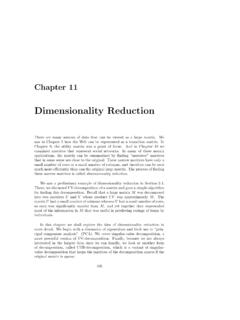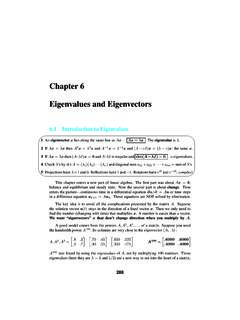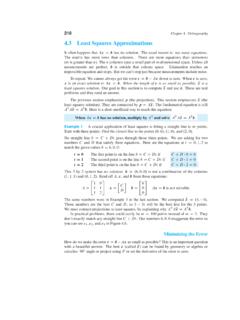Transcription of COMMUTATIVE ALGEBRA Contents - Columbia University
1 COMMUTATIVE ALGEBRA . 00AO. Contents 1. Introduction 4. 2. Conventions 4. 3. Basic notions 5. 4. Snake lemma 7. 5. Finite modules and finitely presented modules 7. 6. Ring maps of finite type and of finite presentation 9. 7. Finite ring maps 10. 8. Colimits 11. 9. Localization 14. 10. Internal Hom 19. 11. Characterizing finite and finitely presented modules 20. 12. Tensor products 21. 13. Tensor ALGEBRA 26. 14. Base change 28. 15. Miscellany 29. 16. Cayley-Hamilton 31. 17. The spectrum of a ring 33. 18. Local rings 37. 19. The Jacobson radical of a ring 38. 20. Nakayama's lemma 39. 21. Open and closed subsets of spectra 40. 22. Connected components of spectra 42. 23. Glueing properties 43. 24. Glueing functions 46. 25. Zerodivisors and total rings of fractions 48. 26. Irreducible components of spectra 49.
2 27. Examples of spectra of rings 50. 28. A meta-observation about prime ideals 53. 29. Images of ring maps of finite presentation 56. 30. More on images 59. 31. Noetherian rings 62. 32. Locally nilpotent ideals 64. 33. Curiosity 66. 34. Hilbert Nullstellensatz 66. 35. Jacobson rings 68. 36. Finite and integral ring extensions 75. 37. Normal rings 80. 38. Going down for integral over normal 83. This is a chapter of the Stacks Project, version 25fb2a70, compiled on Apr 06, 2022. 1. COMMUTATIVE ALGEBRA 2. 39. Flat modules and flat ring maps 85. 40. Supports and annihilators 92. 41. Going up and going down 94. 42. Separable extensions 97. 43. Geometrically reduced algebras 99. 44. Separable extensions, continued 101. 45. Perfect fields 103. 46. Universal homeomorphisms 104. 47. Geometrically irreducible algebras 108.
3 48. Geometrically connected algebras 112. 49. Geometrically integral algebras 114. 50. Valuation rings 114. 51. More Noetherian rings 118. 52. Length 120. 53. Artinian rings 123. 54. Homomorphisms essentially of finite type 124. 55. K-groups 126. 56. Graded rings 128. 57. Proj of a graded ring 129. 58. Noetherian graded rings 134. 59. Noetherian local rings 136. 60. Dimension 139. 61. Applications of dimension theory 143. 62. Support and dimension of modules 144. 63. Associated primes 145. 64. Symbolic powers 149. 65. Relative assassin 149. 66. Weakly associated primes 152. 67. Embedded primes 157. 68. Regular sequences 158. 69. Quasi-regular sequences 160. 70. Blow up algebras 163. 71. Ext groups 165. 72. Depth 169. 73. Functorialities for Ext 172. 74. An application of Ext groups 172.
4 75. Tor groups and flatness 173. 76. Functorialities for Tor 178. 77. Projective modules 179. 78. Finite projective modules 181. 79. Open loci defined by module maps 184. 80. Faithfully flat descent for projectivity of modules 186. 81. Characterizing flatness 186. 82. Universally injective module maps 188. 83. Descent for finite projective modules 194. 84. Transfinite d vissage of modules 195. 85. Projective modules over a local ring 198. 86. Mittag-Leffler systems 199. COMMUTATIVE ALGEBRA 3. 87. Inverse systems 200. 88. Mittag-Leffler modules 201. 89. Interchanging direct products with tensor 205. 90. Coherent rings 210. 91. Examples and non-examples of Mittag-Leffler modules 212. 92. Countably generated Mittag-Leffler modules 214. 93. Characterizing projective modules 216. 94. Ascending properties of modules 217.
5 95. Descending properties of modules 217. 96. Completion 219. 97. Completion for Noetherian rings 223. 98. Taking limits of modules 226. 99. Criteria for flatness 228. 100. Base change and flatness 234. 101. Flatness criteria over Artinian rings 235. 102. What makes a complex exact? 238. 103. Cohen-Macaulay modules 241. 104. Cohen-Macaulay rings 245. 105. Catenary rings 246. 106. Regular local rings 248. 107. Epimorphisms of rings 249. 108. Pure ideals 252. 109. Rings of finite global dimension 255. 110. Regular rings and global dimension 259. 111. Auslander-Buchsbaum 262. 112. Homomorphisms and dimension 263. 113. The dimension formula 265. 114. Dimension of finite type algebras over fields 266. 115. Noether normalization 268. 116. Dimension of finite type algebras over fields, reprise 271.
6 117. Dimension of graded algebras over a field 273. 118. Generic flatness 273. 119. Around Krull-Akizuki 278. 120. Factorization 282. 121. Orders of vanishing 286. 122. Quasi-finite maps 290. 123. Zariski's Main Theorem 293. 124. Applications of Zariski's Main Theorem 297. 125. Dimension of fibres 299. 126. Algebras and modules of finite presentation 301. 127. Colimits and maps of finite presentation 304. 128. More flatness criteria 313. 129. Openness of the flat locus 318. 130. Openness of Cohen-Macaulay loci 321. 131. Differentials 323. 132. The de Rham complex 328. 133. Finite order differential operators 331. 134. The naive cotangent complex 335. COMMUTATIVE ALGEBRA 4. 135. Local complete intersections 342. 136. Syntomic morphisms 348. 137. Smooth ring maps 354. 138. Formally smooth maps 361.
7 139. Smoothness and differentials 366. 140. Smooth algebras over fields 368. 141. Smooth ring maps in the Noetherian case 372. 142. Overview of results on smooth ring maps 374. 143. tale ring maps 375. 144. Local structure of tale ring maps 380. 145. tale local structure of quasi-finite ring maps 385. 146. Local homomorphisms 388. 147. Integral closure and smooth base change 389. 148. Formally unramified maps 390. 149. Conormal modules and universal thickenings 392. 150. Formally tale maps 395. 151. Unramified ring maps 395. 152. Local structure of unramified ring maps 399. 153. Henselian local rings 402. 154. Filtered colimits of tale ring maps 409. 155. Henselization and strict henselization 411. 156. Henselization and quasi-finite ring maps 417. 157. Serre's criterion for normality 420.
8 158. Formal smoothness of fields 422. 159. Constructing flat ring maps 426. 160. The Cohen structure theorem 428. 161. Japanese rings 432. 162. Nagata rings 437. 163. Ascending properties 443. 164. Descending properties 447. 165. Geometrically normal algebras 449. 166. Geometrically regular algebras 451. 167. Geometrically Cohen-Macaulay algebras 452. 168. Colimits and maps of finite presentation, II 453. 169. Other chapters 458. References 460. 1. Introduction 00AP Basic COMMUTATIVE ALGEBRA will be explained in this document. A reference is [Mat70]. 2. Conventions 00AQ A ring is COMMUTATIVE with 1. The zero ring is a ring. In fact it is the only ring that does not have a prime ideal. The Kronecker symbol ij will be used. If R S. is a ring map and q a prime of S, then we use the notation p = R q to indicate COMMUTATIVE ALGEBRA 5.
9 The prime which is the inverse image of q under R S even if R is not a subring of S and even if R S is not injective. 3. Basic notions 00AR The following is a list of basic notions in COMMUTATIVE ALGEBRA . Some of these notions are discussed in more detail in the text that follows and some are defined in the list, but others are considered basic and will not be defined. If you are not familiar with most of the italicized concepts, then we suggest looking at an introductory text on ALGEBRA before continuing. 00AS (1) R is a ring, 00AT (2) x R is nilpotent, 00AU (3) x R is a zerodivisor, 00AV (4) x R is a unit, 00AW (5) e R is an idempotent, 00AX (6) an idempotent e R is called trivial if e = 1 or e = 0, 00AY (7) : R1 R2 is a ring homomorphism, 00AZ (8) : R1 R2 is of finite presentation, or R2 is a finitely presented R1 - ALGEBRA , see Definition , 00B0 (9) : R1 R2 is of finite type, or R2 is a finite type R1 - ALGEBRA , see Definition , 00B1 (10).
10 R1 R2 is finite, or R2 is a finite R1 - ALGEBRA , 00B2 (11) R is a (integral) domain, 00B3 (12) R is reduced, 00B4 (13) R is Noetherian, 00B5 (14) R is a principal ideal domain or a PID, 00B6 (15) R is a Euclidean domain, 00B7 (16) R is a unique factorization domain or a UFD, 00B8 (17) R is a discrete valuation ring or a dvr, 00B9 (18) K is a field, 00BA (19) L/K is a field extension, 00BB (20) L/K is an algebraic field extension, 00BC (21) {ti }i I is a transcendence basis for L over K, 00BD (22) the transcendence degree trdeg(L/K) of L over K, 00BE (23) the field k is algebraically closed, 00BF (24) if L/K is algebraic, and /K an extension with algebraically closed, then there exists a ring map L extending the map on K, 00BG (25) I R is an ideal, 00BH (26) I R is radical, . 00BI (27) if I is an ideal then we have its radical I, 00BJ (28) I R is nilpotent means that I n = 0 for some n N, 0543 (29) I R is locally nilpotent means that every element of I is nilpotent, 00BK (30) p R is a prime ideal, 00BL (31) if p R is prime and if I, J R are ideal, and if IJ p, then I p or J p.




